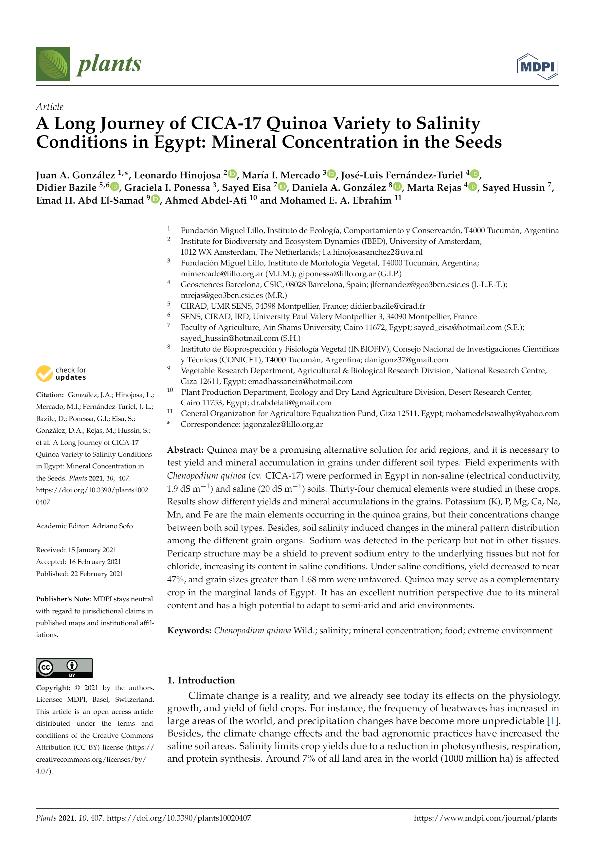Artículo
A long journey of cica-17 quinoa variety to salinity conditions in egypt: Mineral concentration in the seeds
González, Juan A.; Hinojosa, Leonardo; Mercado, María I.; Fernández Turiel, José Luis; Bazile, Didier; Ponessa, Graciela Ines; Eisa, Sayed; Gonzalez, Daniela Alejandra ; Rejas, Marta; Hussin, Sayed; Abd El Samad, Emad H.; Abdel Ati, Ahmed; Ebrahim, Mohamed E. A.
; Rejas, Marta; Hussin, Sayed; Abd El Samad, Emad H.; Abdel Ati, Ahmed; Ebrahim, Mohamed E. A.
 ; Rejas, Marta; Hussin, Sayed; Abd El Samad, Emad H.; Abdel Ati, Ahmed; Ebrahim, Mohamed E. A.
; Rejas, Marta; Hussin, Sayed; Abd El Samad, Emad H.; Abdel Ati, Ahmed; Ebrahim, Mohamed E. A.
Fecha de publicación:
02/2021
Editorial:
MDPI AG
Revista:
Plants
ISSN:
2223-7747
Idioma:
Inglés
Tipo de recurso:
Artículo publicado
Clasificación temática:
Resumen
Quinoa may be a promising alternative solution for arid regions, and it is necessary to test yield and mineral accumulation in grains under different soil types. Field experiments with Chenopodium quinoa (cv. CICA-17) were performed in Egypt in non-saline (electrical conductivity, 1.9 dS m−1 ) and saline (20 dS m−1 ) soils. Thirty-four chemical elements were studied in these crops. Results show different yields and mineral accumulations in the grains. Potassium (K), P, Mg, Ca, Na, Mn, and Fe are the main elements occurring in the quinoa grains, but their concentrations change between both soil types. Besides, soil salinity induced changes in the mineral pattern distribution among the different grain organs. Sodium was detected in the pericarp but not in other tissues. Pericarp structure may be a shield to prevent sodium entry to the underlying tissues but not for chloride, increasing its content in saline conditions. Under saline conditions, yield decreased to near 47%, and grain sizes greater than 1.68 mm were unfavored. Quinoa may serve as a complementary crop in the marginal lands of Egypt. It has an excellent nutrition perspective due to its mineral content and has a high potential to adapt to semi-arid and arid environments.
Archivos asociados
Licencia
Identificadores
Colecciones
Citación
González, Juan A.; Hinojosa, Leonardo; Mercado, María I.; Fernández Turiel, José Luis; Bazile, Didier; et al.; A long journey of cica-17 quinoa variety to salinity conditions in egypt: Mineral concentration in the seeds; MDPI AG; Plants; 10; 2; 2-2021; 1-13
Compartir
Altmétricas



